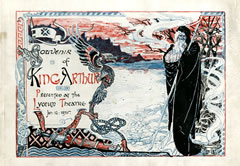King Arthur: A Drama in a Prologue and Four Acts
You may click on the thumbnail images to view them full screen



Carr, J. Comyns. King Arthur: A Drama in a Prologue and Four Acts. Printed for Private Use Only. London: Chiswick Press, 1893. This is a copy of the privately printed edition, published prior to the trade edition and the first performance of the play in 1895. This copy is inscribed by the author and contains changes to the text in his hand.
Perhaps the most popular Arthurian play of the Victorian era was King Arthur (1895) by J. Comyns Carr (1849-1916), a spectacular production that was the Camelot of its era. Not only did it star two of the most famous actors of the day, Henry Irving as Arthur and Ellen Terry as Guinevere, but its sets and costumes were designed by Edward Burne-Jones and its music scored by Sir Arthur Sullivan. The play, which makes extensive use of dramatic spectacle, had a long run in England and toured the United States and Canada. A fire that destroyed the scenery in 1898 ended plans for a revival of the play.
The scope of the play, which treats Arthur's career from the time he receives Excalibur until his death, requires considerable condensing of the traditional material; but Carr maintains unity by focusing on a few principal characters. His primary interest is in Arthur, Guinevere, and Mordred, who is at times Iago-like in his deceit and manipulation. Carr's Lancelot is less interesting and less heroic than is usual. Because he fears that Mordred will reveal to Arthur the love between him and the queen, Lancelot delays reporting to the king a threat to the kingdom. But, in a dramatic touch lacking in Malory or Tennyson, he redeems himself by slaying Mordred after the villain has given Arthur his fatal wound. Like other dramatists, such as Henry Newbolt, Carr blends elements from Malory, Tennyson, and Shakespeare and adds touches of his own imagination to create a spectacular new version of the Arthurian story.